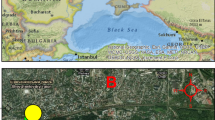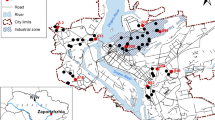Abstract
This study evaluates the present day effects of air pollutants emitted from an iron sintering plant near Wawa (Ontario, Canada) decades ago (1939–1998). During smelting and refining of iron ore, gaseous sulfur-rich emissions and large amounts of metal-containing (iron oxides) particulate materials were released in to the air, and eventually settled onto vegetation and soil cover. We test the feasibility of using magnetic measurements to investigate and quantify the soil pollution resulting from the sintering plant. Surface and subsurface magnetic susceptibility measurements, as well as various magnetic mineral properties, have been collected in a scheme designed to mimic the previously determined pollutant contamination zones. A total of 50 sites were sampled (with a sampling grid of 250 m) within and around the smelter kill zone to the northwest of Wawa. Results were plotted on cross sections perpendicular (X-X′) and parallel (Y-Y′) to the dominant wind direction in order to investigate magnetic properties of the soil samples as a function of both wind direction and distance from the source. Samples located in Rao and LeBlanc’s (The Bryologist 70:141–17, 1967) pollution zones 1 and 2 typically have κ in-situ values >120 × 10−5 SI, while the zone 3 and 4 results are <100 × 10−5 SI. Magnetic susceptibility enhancements at depths of 5–10 cm were found to be related to the presence of magnetic spherules (fly-ashes) at sites on the wind-parallel Y-Y′ profile in the previously defined kill zone. An estimated minimum migration rate of iron-rich particulates is calculated for coarse sand and silt/clay sites as 0.24 and 0.1 cm/year, respectively.














Similar content being viewed by others
References
Allard, B., Hakansson, K., Karlsson, S., & Sigas, E. (1991). A field study of diffusion controlled migration of copper, zinc and cadmium in a clay formation. Water, Air, and Soil Pollution, 57–58, 259–68.
Bartington Instruments (2000). Operation manual for MS2 magnetic susceptibility system (OM0408), 45, 71 pp. Available from www.bartington.com.
Blaha, U., Sapkota, B., Appel, E., Stanjek, H., & Rösler, W. (2008). Micro-scale grain-size analysis and magnetic properties of coal-fired power plant fly ash and its relevance for environmental magnetic pollution studies. Atmospheric Environment, 48, 8359–8370. doi:10.1016/j.atmosenv.2008.07.051.
Brook, R. D., Rajagopalan, S., Pope, C. A., III, American Heart Association Council on Epidemiology and Prevention, Council on the Kidney in Cardiovascular Disease, and Council on Nutrition, Physical Activity and Metabolism, et al. (2010). Particulate matter air pollution and cardiovascular disease: an update to the scientific statement from the American Heart Association. Circulation, 121(21), 2331–2378. doi:10.1161/CIR.0b013e3181dbece1.
Cranstone, D. A. (2002). A history of mining and mineral exploration in Canada and outlook for the future, Natural Resources Canada, Minister of Public Works and Government Services Canada, Catalogue no. M37-51/2002E, pp.51, ISBN 0-662-32680-6.
Day, R., Fuller, M., & Schmidt, V. A. (1977). Hysteresis properties of titonomagnetites: grain size and composition dependence. Physics of the Earth and Planetary Interiors, 13, 260–267.
Dearing, J. A., Hay, K. L., Baban, S. M. J., Huddleston, A. S., Wellington, E. M. H., & Loveland, P. J. (1996). Magnetic susceptibility of soil: an evaluation of conflicting theories using a national data set. Geophysical Journal International, 127, 728–734.
Dearing, J. A., Bird, P. M., Dann, R. J. L., & Fenjamin, S. F. (1997). Secondary ferromagnetic minerals in Welsh soils: a comparison of mineral magnetic detection methods and implications for mineral formation. Geophysical Journal International, 130, 727–736.
Dickman, M. D., & Thode, H. G. (1985). The rate of lake acidification in four lakes north of Lake Superior and its relationship to downcore sulphur isotope ratios. Water, Air, and Soil Pollution, 26, 233–253.
Dunlop, D. J. (2002). Theory and application of the day plot (Mrs/Ms versus Hcr/Hc): 1. Theoretical curves and tests using titonomagnetite data. Journal of Geophysical Research, 107(B3), 2056. doi:10.1029/2001JB000486.
Evans, M.E. & Heller, F. (2003). Environmental magnetism: principles and applications of enviromagnetics, Academic, San Diego, CA., 299 pp.
Freedman, B., & Hutchinson, T. C. (1980). Long-term effects of smelter pollution at Subury, Ontario, on forest community composition. Canadian Journal of Botany, 58, 2123–2140.
Garçon, G., Shirali, P., & Garry, S. (2000). Polycyclic aromatic hydrocarbon coated onto Fe2O3 particles: assessment of cellular membrane damage and antioxidant system disruption in human epithelial lung cells (L132) in culture. Toxicology Letters, 117, 25–35.
Gizyn, W. (2003). Phytotoxicology 2001 and 2002 investigations: Algoma Ore Division, Twp. Of Michipicoten (Wawa), Ontario Ministry of the Environment and Climate Change, Report no. Phyto-S5021-2002.
Gordon, A. G., & Gorham, E. (1963). Ecological aspects of air pollution from an iron-sintering plant at Wawa, Ontario. Canadian Journal of Botany, 41, 1063–1078.
Heller, F., Strzyszcz, Z., & Magiera, T. (1998). Magnetic record of industrial pollution in forest soils of Upper Silesia, Poland. Journal of Geophysical Research, 103(B8), 767–774.
Hoffmann, V., Knab, M., & Appel, E. (1999). Magnetic susceptibility mapping of roadside pollution. Journal of Geochemical Exploration, 66, 313–326.
Hrouda, F. (1994). A technique for the measurement of thermal changes of magnetic susceptibility of weakly magnetic rocks by the CS-2 apparatus and KLY-2 Kappabridge. Geophysical Journal International, 118, 604–612.
Jackson, M., Gruber, W., Marvin, J., & Banerjee, S. K. (1988). Partial anhysteretic remanence and its anisotropy: applications and grainsize-dependence. Geophysical Research Letters, 15(5), 440–443.
Jacques, D., Simunek, J., Mallants, D., & van Genuchten, M. T. (2008). Modelling coupled water flow, solute transport and geochemical reactions affecting heavy metal migration in a podzol soil. Geoderma, 145, 449–461.
Jordanova, N. V., Jordanova, D. V., Veneva, L., Yorova, K., & Petrovsky, E. (2003). Magnetic response of soils and vegetation to heavy metal pollution—a case study. Environmental Science and Technology, 37, 4417–4424.
Jӓrup, L. (2003). Hazards of heavy metal contamination. British Medical Bulletin, 68, 167–182.
Kapička, A., Petrovsky, E., Ustjak, S., & Machackova, K. (1999). Proxy mapping of fly-ash pollution of soils around a coal-burning power plant: a case study in the Czech Republic. Journal of Geochemical Exploration, 66, 291–297.
Kapička, A., Kodesova, R., Petrovsky, E., Hulka, Z., Grison, H., & Kaska, M. (2011). Experimental study of fly-ash migration by using magnetic method. Studia Geophysica et Geodaetica, 55, 683–696. doi:10.1007/s11200-010-0078-7.
Krupp, R. E. (1991). Smythite, greigite, and mackinawite: new observations on natural low-temperature iron sulfides. In M. Pagel & J. L. Leroy (Eds.), Source, transport and deposition of metals (pp. 193–195). Rotterdam: Balkema.
Lecoanet, H., Leveque, F., & Ambrosi, J. P. (2001). Magnetic properties of salt-marsh soils contaminated by iron industry emissions (southeast France). Journal of Applied Geophysics, 48, 67–81.
Leonhardt, R. (2006). Analyzing rock magnetic measurements: the RockMagAnalyzer 1.0 software. Computers & Geosciences, 32, 1420–1431.
Liu, Q. S., Roberts, A. P., Torrent, J., Horng, C. S., & Larrasoana, J. C. (2007). What do the HIRM and S-ratio really measure in environmental magnetism? Geochemistry, Geophysics, Geosystems, 8, Q09011. doi:10.1029/2007GC001717.
Liu, Q., Roberts, A. P., Larrasoana, J. C., Banerjee, S. K., Guyodo, Y., Tauxe, L., & Oldfield, F. (2012). Environmental magnetism: principles and applications. Reviews of Geophysics, 50, RG4002/2012.
Lusis, M. A., Tang, A. J. S., Chan, W. H., Yap, D., Kurtz, J., & Misra, P. K. (1986). Sudbury smelter impact on atmospheric deposition of acidic substances in Ontario. Water, Air, and Soil Pollution, 30, 897–908.
Magiera, T., Strzyszcz, Z., Kapicka, A., & Petrovsky, E. (2006). Discrimination of lithogenic and anthropogenic influences on topsoil magnetic susceptibility in Central Europe. Geoderma, 130, 299–311.
Maher, B. (1998). Magnetic properties of some synthetic sub-micron magnetites. Geophysical Journal, 94, 83–96.
Maskall, J., Whitehead, K., & Thornton, I. (1995). Heavy metal migration in soils and rocks at historical smelting sites. Environmental Geochemistry and Health, 17, 127–138.
Morris, T. (2001). Quaternary geology of the Wawa area, northeastern Ontario, Ontario Geological Survey Open File Report 6055, 67 pp.
Ontario Ministry of the Environment and Climate Change (1999). Studies of the terrestrial environment in the Wawa area, 1998–1999, Ontario Ministry of the Environment Report No. SDB-047-3511-1999, ISBN 0-7778-9220-0.
Peters, C., & Thompson, R. (1998). Magnetic identification of selected natural iron oxides and sulphides. Journal of Magnetism and Magnetic Materials, 183, 365–374.
Petrovský, E., Kapička, A., Jordanova, N., Knab, M., & Hoffmann, V. (2000). Low-field magnetic susceptibility: a proxy method of estimating increased pollution of different environmental systems. Environmental Geology, 39, 3–4.
Rao, D.N. & LeBlanc, F. (1967). Influence of an iron-sintering plant on corticolous epiphytes in Wawa, Ontario. The Bryologist 70(2)141–157 pp.
Reynolds, R. L., Reheis, M. C. M., Neff, J. C., Goldstein, H., & Yount, J. (2006). Late Quaternary eolian dust in surficial deposits of a Colorado Plateau grassland: controls on distribution and ecologic effects. Catena, 66, 251–266.
Sandker, Y., & Cioppa, M. T. (2016). Magnetic susceptibility mapping of the Sudbury area, Ontario, Canada: evaluating pollution distributions decades later. Canadian Journal of Earth Sciences, 53, 466–484.
Sapkota, B., & Cioppa, M. T. (2011). Assessing the use of magnetic methods to monitor vertical migration of metal pollutants in soil. Water, Air, & Soil Pollution. doi:10.1007/s11270-011-0911-9.
Sapkota, B., Cioppa, M. T., & Gagnon, J. E. (2012). Investigation of the changes in magnetic and chemical properties of soil during plant growth in a controlled environment. Environmental Earth Sciences, 65, 385–399. doi:10.1007/s12665-011-1099-4.
Schibler, L., Boyko, T., Ferdyn, M., Gajda, B., Höll, S., Jordanova, N., Rösler, W., & Team, M. A. G. P. R. O. X. (2002). Topsoil magnetic susceptibility mapping: data reproducibility and compatibility, measurement strategy. Studia Geophysica et Geodaetica, 46, 43–57.
Shi, R., & Cioppa, M. T. (2006). Magnetic survey of topsoils in Windsor-Essex County, Canada. Journal of Applied Geophysics, 60, 201–212.
Sláma, J., Šoka, M., Grusková, A., Gonzalez, A., & Jančárik, V. (2011). Hopkinson effect study in spinel and hexagonal ferrites. Journal of Electrical Engineering 62(4) 239–243. doi: 10-2478/v10187-011-0038-7.
Strzyszcz, Z. & Magiera, T. (1998). Magnetic susceptibility and heavy metals contamination in soils of Southern Poland. Physical Chemistry Earth 23(9-10), 1127-1131 pp.
Thompson, R., & Oldfield, F. (1986). Environmental magnetism. London: Allen and Unwin.
Thurston P.C., Osmani L.A. & Stone D. (1991). Northwestern Superior Province: review and terrane analysis. In: Thurston P.C., Williams H.R., Sutclife H.R., Stott G.M. (eds) Geoology of Ontario, Ontario Geological Survey Spectron 4(1):81–144.
Wagner, J. (1991). Retention of heavy metals from blast-furnace dedusting sludges by a clayey subsoil. Water, Air, and Soil Pollution, 57–58, 351–7.
Walden, J., Smith, J.P. & Oldfield, F. (1999). Environmental magnetism, a practical guide. Quaternary Research Association Technical Guide 6, 243 pp.
Williams, H. R, Stott, G. M., Heather, K. B., Muir, T.L., & Sage, R. P. (1991). Wawa Subprovince; in Geology of Ontario, Ontario Geological Survey, Special Volume 4, Part 1, 485–539.
Winterhalder, K., Lautenbach, W. E., & Beckett, P. (2001). The Sudbury regional land reclamation program: a case study. In J. B. Burley (Ed.), Environmental design for reclaiming surface mines (pp. 286–294). Lewinston: The Edwin Mellen Press.
Acknowledgments
This study was supported by an Ontario Premier’s Excellence Research Award and Natural Sciences and Research Council of Canada (NSERC) Discovery Grant to M.T.C. The Paleomagnetic and Rock Magnetic Laboratory was funded by the Canada Foundation for Innovation and the Ontario Innovation Trust. We would like to thank S. Holland and S. Joshi for their field and laboratory assistance.
Author information
Authors and Affiliations
Corresponding author
Rights and permissions
About this article
Cite this article
Yurtseven-Sandker, A., Cioppa, M.T. Tracking the Historical Traces of Soil Pollution from an Iron-Sintering Plant by Using Magnetic Susceptibility in Wawa, Ontario, Canada. Water Air Soil Pollut 227, 434 (2016). https://doi.org/10.1007/s11270-016-3140-4
Received:
Accepted:
Published:
DOI: https://doi.org/10.1007/s11270-016-3140-4




